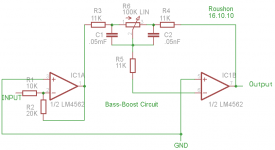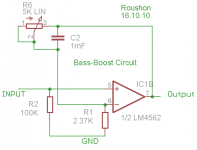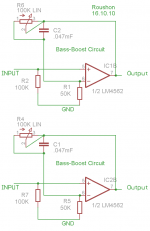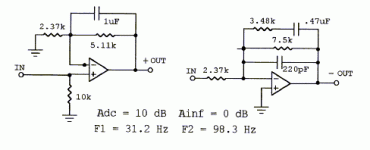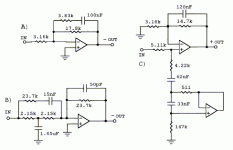I feel a bass-boost circuit is needed for the MJK OB I built sometime back.
The circuit is based on an application circuit in the datasheet of LM4562.
I look forward to your comments and suggestions. Especially if it is suitable
for the OB (it is the simple version one, not the U or H-frame one). The
circuit will be attached in between the cd-player and the amplifier. The
amplifier does not have any tone (bass, tribble) control.
Thanks and Regards
Roushon
P.S. C2 is also .05mF. by mistake I typed it nF
The circuit is based on an application circuit in the datasheet of LM4562.
I look forward to your comments and suggestions. Especially if it is suitable
for the OB (it is the simple version one, not the U or H-frame one). The
circuit will be attached in between the cd-player and the amplifier. The
amplifier does not have any tone (bass, tribble) control.
Thanks and Regards
Roushon
P.S. C2 is also .05mF. by mistake I typed it nF
Attachments
Last edited:
My dear friend !!! Are you going to put operationals along the path ,eh ??
I used to have the same problem ,like most of OBers !!! Firstly ,I just used a portable CD player which had a good bass-boost . When it went active ,as I didn't want to mess up the PURITY of the signal passing thru only the tube crossover , I let a single IC take care of boosting the subsonic frequencies . Linkwitz's site shows two shelving filters ,I used the one with 1uF in it!!! ..then below on the same page , also the same shelving filter+notch ,with 2 operationals.
Finished story !!!
I used to have the same problem ,like most of OBers !!! Firstly ,I just used a portable CD player which had a good bass-boost . When it went active ,as I didn't want to mess up the PURITY of the signal passing thru only the tube crossover , I let a single IC take care of boosting the subsonic frequencies . Linkwitz's site shows two shelving filters ,I used the one with 1uF in it!!! ..then below on the same page , also the same shelving filter+notch ,with 2 operationals.
Finished story !!!
Thanks
Thanks. Thanks a lot Pico. This is exactly what I was looking for. The cd player (Marantz
cd5003) I have does not have a bass-boost facility. I will try the shelving filter+notch one
but tell me what kind of capacitor I should use. Is polyester OK?
Thanks and regards
Roushon
My dear friend !!! Are you going to put operationals along the path ,eh ??
I used to have the same problem ,like most of OBers !!! Firstly ,I just used a portable CD player which had a good bass-boost . When it went active ,as I didn't want to mess up the PURITY of the signal passing thru only the tube crossover , I let a single IC take care of boosting the subsonic frequencies . Linkwitz's site shows two shelving filters ,I used the one with 1uF in it!!! ..then below on the same page , also the same shelving filter+notch ,with 2 operationals.
Finished story !!!
Thanks. Thanks a lot Pico. This is exactly what I was looking for. The cd player (Marantz
cd5003) I have does not have a bass-boost facility. I will try the shelving filter+notch one
but tell me what kind of capacitor I should use. Is polyester OK?
Thanks and regards
Roushon
Any will fit ,I had two BP around . But ...!! Remember that the examples shown on Linkwitzlab's page are for studying the stages for a fully active multi-way OB
system ,and each section would end on being connected to ampli-speaker only !
Are you sure that the circuit in exam is not giving any "ringing" or something
to the upper part of the frequency band ?
Also a passive RC net -yes ,a bass boost 😱-might work ,without involving the use of ICs . I suggest to use each half of it and try the simple shelving one ,then ear and judge .
system ,and each section would end on being connected to ampli-speaker only !
Are you sure that the circuit in exam is not giving any "ringing" or something
to the upper part of the frequency band ?
Also a passive RC net -yes ,a bass boost 😱-might work ,without involving the use of ICs . I suggest to use each half of it and try the simple shelving one ,then ear and judge .
OB with passive crossover
The MJK OB I am playing is with passive crossover exactly as in the
MJK's note. In an active system there are multiple number of Opamp
in the signal path as I see the Linkwitz's page. I know less is better. I
will remain in the passive setting but would like to raise the low frequency without bothering the high.
So if I do not use any buffer and use a non-inverting version of the circuit I
posted, then is it OK? Here I will have both boost and cut and in between.
On my desk I have two OPA627, one LME49710, one LM4562 and several
NE5532. Does the choice of a better Opamp make a diference? I am
reluctant to use the passive boost circuit as it attenuates the high
rather than raising the low.
Now what I hear from the OB is: the Fostex is a bit too loud compared
to the Eminence. No ringing from any of them. If I raise the volume to
hear the bass then the Fostex hurts my ear. The same OB I played with a
different cd-player which has a bass-boost and it sounded much better
though it did not have detail due to the ouput quality of the cd-player.
Roushon.
The MJK OB I am playing is with passive crossover exactly as in the
MJK's note. In an active system there are multiple number of Opamp
in the signal path as I see the Linkwitz's page. I know less is better. I
will remain in the passive setting but would like to raise the low frequency without bothering the high.
So if I do not use any buffer and use a non-inverting version of the circuit I
posted, then is it OK? Here I will have both boost and cut and in between.
On my desk I have two OPA627, one LME49710, one LM4562 and several
NE5532. Does the choice of a better Opamp make a diference? I am
reluctant to use the passive boost circuit as it attenuates the high
rather than raising the low.
Now what I hear from the OB is: the Fostex is a bit too loud compared
to the Eminence. No ringing from any of them. If I raise the volume to
hear the bass then the Fostex hurts my ear. The same OB I played with a
different cd-player which has a bass-boost and it sounded much better
though it did not have detail due to the ouput quality of the cd-player.
Roushon.
Hi,
You could use a passive shelving circuit on the end of the CD lead.
similar to : Baffle Step Compensation or L-pad the Fostex.
rgds, sreten.
You could use a passive shelving circuit on the end of the CD lead.
similar to : Baffle Step Compensation or L-pad the Fostex.
rgds, sreten.
Hi,
You could use a passive shelving circuit on the end of the CD lead.
similar to : Baffle Step Compensation or L-pad the Fostex.
rgds, sreten.
Thanks Sreten, I like the Baffle step compensation circuit you mentioned.
I will try it.
In the mean time I made a simple modification in the Linkwitz' shelving
filter to have boost and cut options as attached. Is it OK?
Roushon
Attachments
Are you using an LM3886 amp ? Searching for "bass boost " around the net , I arrived at this circuit :How to build 10W Audio Amplifier with Bass-boost (circuit diagram)
Would it be safe to put that network in the FB path of the 3886 ?!??!
Would it be safe to put that network in the FB path of the 3886 ?!??!
Are you using an LM3886 amp ? Searching for "bass boost " around the net , I arrived at this circuit :How to build 10W Audio Amplifier with Bass-boost (circuit diagram)
Would it be safe to put that network in the FB path of the 3886 ?!??!
Hi Pico
I have seen this circuit while searching the net. It will be possible
to impliment it in LM3886. But in my case I am unable to do this for two
reasons.
1. It is difficult for me to take out the pcb from its cabinet, it is
in an air-tightly sealed cabinet with lots of wire (as I applied
`all grounds go to the star ground' principle literary). Although
this difficulty helped me to get a silent amp. I have spent long
time behind this amp.
2. Each channel consists of parallel of two LM3886. So if I employ the
bass boost circuit to both of them it will be very difficult to get
stability I think.
Simply I am afraid to try that. It will be a very very hard work.
Thanks and regards
Roushon.
With some more flexibility
There is a buffer stage using OPA 627 in the amp which is easily accessible. I can
implement the idea as attached on this stage. But I do not know if it is OK.
Roushon
There is a buffer stage using OPA 627 in the amp which is easily accessible. I can
implement the idea as attached on this stage. But I do not know if it is OK.
Roushon
Attachments
Last edited:
It should be easy to mount on breadboard a shelving lowpass or shelving+notch shown on Linkwitz site . Just put a cap (nobody knows !)at the input .
What's the purpose of the buffer ? Is it just an attenuator(volume control)+unity gain ?
....good luck !
What's the purpose of the buffer ? Is it just an attenuator(volume control)+unity gain ?
....good luck !
It should be easy to mount on breadboard a shelving lowpass or shelving+notch shown on Linkwitz site . Just put a cap (nobody knows !)at the input .
What's the purpose of the buffer ? Is it just an attenuator(volume control)+unity gain ?
....good luck !
Thanks for the suggestion. I will try first the passive bass compensation
from ESP page, it is easier, then if not satisfied will go on to the opamp
version. Will post result here.
The buffer is to supply enough current to two LM3886, also it helps
to connect to unknown sources. I followed National Application
notes.
Regards
Roushon.
If you model with The Edge baffle simulator, it includes the compensation designer that will design this circuit for you.
Home of the Edge
John
Home of the Edge
John
If you model with The Edge baffle simulator, it includes the compensation designer that will design this circuit for you.
Home of the Edge
John
Thank you for the suggestion. But the problem with edge is that it does not
support drivers with different sizes. I tried edge before to find a baffle size I need, but
then when I found the MJK design I thought I would not need bass compensation.
I will see again plugging the the MJK baffle size and the 15 inch.
Regards
Roushon
I'm not sure if this is what you are looking for, but in case it may be useful, consider the Excel spreadsheet by John K. called A, B, C, Dipole. It is meant for dipoles and does use both the driver diameter and the T/S parameters in the calculations.Thank you for the suggestion. But the problem with edge is that it does not
support drivers with different sizes. I tried edge before to find a baffle size I need, but
then when I found the MJK design I thought I would not need bass compensation.
I will see again plugging the the MJK baffle size and the 15 inch.
Regards
Roushon
Dave
Thank you for the suggestion. But the problem with edge is that it does not
support drivers with different sizes. I tried edge before to find a baffle size I need, but
then when I found the MJK design I thought I would not need bass compensation.
I will see again plugging the the MJK baffle size and the 15 inch.
Regards
Roushon
I'm not quite sure what you mean by this. You can input both driver shape and diameter in the input fields. If you mean multiple size drivers at one time, yes it will not do this. However that doesn't matter. The baffle response is going to be the same no matter what drive you put on it.
John
a Baxandall bass tone control with the turnover freq set to where the baffle drop off occurs would be a simple and adjustable solution
Another option is to buy one of the minidsp units for $125. While you want to do a passive system, for the price you still have the ability to EQ the baffle step/baffle compensation. then you can use the additional EQ on the input to EQ the room.
John
John
a Baxandall bass tone control with the turnover freq set to where the baffle drop off occurs would be a simple and adjustable solution
This is what I was trying to do in the first post of this thread. But I had to add a
buffer. Can I connect the cd-player output directly to the Baxandall bass control?
I do not find any Baxandall type bass control with non-inverted opamp except for
the one in the Linkwitz site Pico suggested. I also tried to make this shelving
low-pass from this site adjustable by using a lin potentiometer in place of the feedback
resistor. Not sure if that will work.
In the MJK notes the final response curve shows that the bass starts droping at
around 100Hz and drops for about 20dB at 20Hz and 10dB at 50Hz etc. So I need a bass
compensation for this setup. If any of you have a ready made circuit to compensate this
bass drop then please post. The Linkwitz shelving low-pass without notch filter does help
to a certain extent. Recovers about 9dB at 20Hz and 4dB at 110Hz etc. And the one with
notch filter recovers about 15dB at 20Hz, 12dB at 110Hz and 3dB at 880Hz etc. I am not
sure if the notch filter will correct the extra dBs after 100Hz.
And the passive bass-boost in the ESP site gives about 6dB at 50Hz. etc
Now that I have enough information, I have to start experimenting with different possibility
and hear the sound by my ear.
Roushon.
Attachments
Last edited:
- Status
- Not open for further replies.
- Home
- Loudspeakers
- Multi-Way
- A bass-boost circuit for OB
